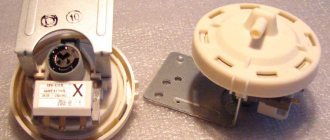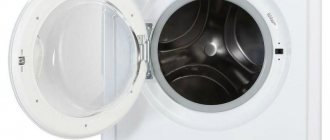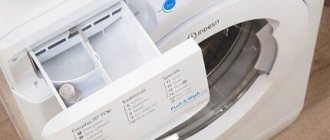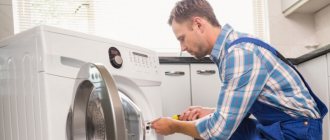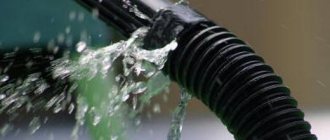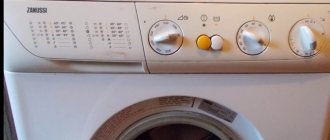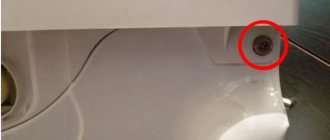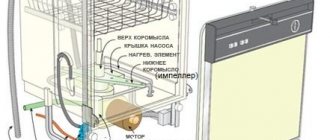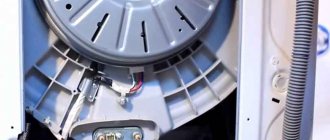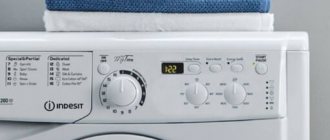Automatic washing machines (hereinafter also referred to as SM, SMA) of the Ariston brand are well known and popular in Russia. But just like any mechanical product, washing machines sometimes fail. The reasons are most often wear and tear or manufacturing defects in components and parts, leading over time to various breakdowns of Ariston washing machines.
A washing machine is an appliance containing many mechanical and electronic parts.
Problems in the Ariston Aqualtis series CM, as well as in other models of washing units, are associated not only with manufacturing defects, but also with improper installation and operation of the CM. Many of the errors in your work can be corrected yourself.
Service maintenance
Page 12
- Image
- Text
+15
Before contacting an Authorized Service Center: • Make sure that you cannot fix the problem yourself (see page 11).
• Run the program again to check the machine's functionality.
• Otherwise, contact the Authorized Service Center at the telephone number indicated in
warranty document.
Do not use the services of persons not authorized by the Manufacturer.
When making repairs, require the use of original spare parts.
When contacting the Authorized Service Center, please inform:
• type of fault;
• number of the warranty document (service book, service certificate, etc.);
• machine model (Mod.) and serial number (S/N), indicated on the information plate, located
placed on the back of the washing machine.
Service
service
Problems with water heating
If during the washing mode the washing machine freezes for a long time, stops, does not heat up, or constantly drains water, the causes of the breakdown should be sought in the heating circuit. The device will signal these problems with codes F04 , F07 or F08 .
Failure of the heating element or pressure switch and codes F04, F07
In washing modes where heating is required, the error may appear immediately after startup, or after drawing water, but rinsing or washing in cold water will work normally. In this case, there are several options for solving the problem (besides the standard turn on/off the machine to reboot the controller).
If the code appears on the display during the washing phase or during startup (the machine does not even want to draw water), most likely the reason lies in the heating element itself. It can “pierce” onto the housing when the contacts come off or simply burn out.
To fix the problem, you need to get to the heating element, check all its connections, change the resistance with a multimeter (with a power of 1800 W it should produce about 25 Ohms).
If the device collects and then immediately drains water, the cause may be a breakdown of the pressure switch - the water level sensor. If there is a problem, this element can provide the controller with information that the heating element was not immersed in water, which is why the machine does not start heating.
In this case, it is necessary to check the water pressure sensor tube with the pressure switch (the hose may become clogged, kinked, frayed, or come off). At the same time, inspect the contacts of the sensor itself - they may need to be cleaned. But more precisely, code F04 - most likely, the part will require replacement.
Errors in the operation of the drain or water intake
If the machine cannot draw water or, on the contrary, stops working, although its tank is full, codes F05 , F11 or H2O . Let's try to understand the essence of such breakdowns.
Drain violations and codes F05 or F11
Error F05/F5 always lights up when the drum is full, but attempts to force drain it remain unsuccessful - the machine “does not release” water and continues to signal a breakdown.
In this case, a cracking noise may be heard, as if some foreign object had hit the fan impeller, or a humming sound from the pump. Such a breakdown is a fairly common occurrence with Ariston machines, and in most cases you can fix it yourself.
Most often, the problem lies in a banal blockage of the drain filter or drain hose - when washing, various hairs, threads, buttons, particles of dirt and small debris are separated from things, which gradually clog the gap for water to exit.
To remove them, you need to manually drain the water through the filter (if it is not the hose that is clogged) or manually scoop out the drum.
Then check the condition of the drain filter (small hatch at the bottom of the machine), the pipe itself, and rinse the hose under good water pressure. At the same time, inspect the siphon or pipe if the drain is organized directly into the sewer.
Then reassemble the system in the reverse order, turn on the machine to the rinse program, make sure that it has filled with water, and forcefully switch to spin - if error F05 does not appear and the drain works, then the problem is solved.
If the problem is not a blockage, the following options are possible:
- Failure of the drain pump/pump - the part may simply require replacement, having honestly exhausted its service life, or it may fail due to the penetration of a foreign object, a broken motor coil, or a short circuit. First, you should disassemble the pump, remove debris, check the chain and try to start the machine again. If the problem persists, you will have to replace the filter.
- Malfunctions in the operation of the electronic controller - the corresponding tracks or radio components on the microcircuit may burn out or oxidize (most often due to the same high humidity), or a firmware failure may occur.
- Failure of the pressure switch - if the sensor provides information that the tank is empty, the machine simply will not start the draining program, so the faulty part must be replaced.
- Wiring problems - you need to check if there is power to the drain pump when it is turned on.
Similar problems can occur with error F11 . Although most often this code indicates a breakdown of the drain pump (this is where the inspection should begin), it can also be due to incorrect operation of the pressure switch, controller, or damaged wiring.
Problems with water intake and H2O code
Another common error, familiar firsthand to owners of Ariston machines, is the H2O , which indicates problems with the water supply. Usually it occurs 5-7 minutes after start (in rare cases - during rinsing), and the device may not let in water at all, or may collect too much of it.
Sometimes the H2O can appear chaotically in different programs, but its characteristic feature is that the drain and spin modes always work flawlessly.
Possible causes of failure:
- Lack of water in the water supply, insufficient pressure or the supply valve to the device is closed. The actions here are clear: open the tap, wait for the water supply to be restored.
- Damage to the water intake valve, which “allows” water into the device - if it breaks, it is easier to replace this part with a new one than to try to repair it.
- Malfunction of the pressure switch - if the hose is clogged or damaged or the sensor itself breaks down, the machine will constantly draw in and immediately drain water, displaying the H2O .
But if all the elements work, the problem may be a signal break due to damaged wiring or failure of the electronic controller.
Problems with water heating
If during the washing mode the washing machine freezes for a long time, stops, does not heat up, or constantly drains water, the causes of the breakdown should be sought in the heating circuit. The device will signal these problems with codes F04 , F07 or F08 .
Failure of the heating element or pressure switch and codes F04, F07
In washing modes where heating is required, the error may appear immediately after startup, or after drawing water, but rinsing or washing in cold water will work normally. In this case, there are several options for solving the problem (besides the standard turn on/off the machine to reboot the controller).
If the code appears on the display during the washing phase or during startup (the machine does not even want to draw water), most likely the reason lies in the heating element itself. It can “pierce” onto the housing when the contacts come off or simply burn out.
To fix the problem, you need to get to the heating element, check all its connections, change the resistance with a multimeter (with a power of 1800 W it should produce about 25 Ohms).
If the device collects and then immediately drains water, the cause may be a breakdown of the pressure switch - the water level sensor. If there is a problem, this element can provide the controller with information that the heating element was not immersed in water, which is why the machine does not start heating.
In this case, it is necessary to check the water pressure sensor tube with the pressure switch (the hose may become clogged, kinked, frayed, or come off). At the same time, inspect the contacts of the sensor itself - they may need to be cleaned. But more precisely, code F04 - most likely, the part will require replacement.
In some cases, the problem may be in the board itself, faulty wiring or contact groups in the area from the board to the heating element or water level sensor. Therefore, you should ring all the elements of the control unit associated with the operation of the heating circuit, and if necessary, replace the burnt tracks or the controller itself.
Heating circuit faults and F08 symbol
If the water heating does not work correctly (or the machine “seems” that it starts when the tank is empty), error code F08 . The cause is most often a malfunction in the pressure switch circuit.
This problem can occur due to high humidity in the room, which negatively affects the controller. To make sure the board is in order, inspect it, wipe it dry, or blow it with a hairdryer.
Another simple solution to the issue could be the disconnected contacts of the heating element and the pressure switch, especially if the device was started for the first time after transportation. In other cases, a more professional inspection will be required with possible replacement of parts.
Possible malfunctions of Ariston machines, indicated by code F8:
- If the washing mode is interrupted immediately after starting or during the washing phase and the device does not heat the water, the heating element will most likely need to be replaced.
- If the machine stops after starting, when switching to the rinsing mode, or does not spin, it is possible that the contact group of the heating element relay is “stuck” on the controller when it is on. In this case, you can replace the failed elements of the microcircuit and, if necessary, reflash the board.
- If the device “freezes” in various modes (and this can be either washing, rinsing or spinning), the wiring or contacts in the heater circuit may be damaged, or the pressure switch may break down, which considers that not enough water is entering the machine.
But if, when checking all the connections of the circuit and separately the pressure switch, the heating element relay and the heating element itself, no damage is detected, you will have to change the controller.
Principles for determining the fault code
In cars equipped with an information display, it is not difficult to find out the error code - it will appear in bright yellow or green.
But if the model is less “advanced”, to find out the cause of the breakdown you will have to unravel the code programmed by the manufacturer, based on the prompts of the indicator lights.
Algorithm for determining a breakdown based on the light bulb signal:
- We remember the model of our Ariston machine (or check the information on the case or in the instructions).
- We remember which indicators indicate a breakdown.
- We find our device in the pictures.
- We determine the digital value for each indicator.
Other errors and their interpretation
In total, Ariston machines have 19 code signals indicating problems, of which we have examined the most common ones.
But let’s briefly talk about other possible malfunctions in the operation of equipment:
- F03 – temperature sensor failure. You need to check the resistance of the sensor itself (normally about 20 ohms), as well as the circuit to the controller. If necessary, replace damaged parts.
- F06 - indicates a problem in the circuit of the hatch locking device for Ariston cars on the Arcadia platform (Low-End and Aqualtis series), as well as problems with the control buttons for Dialogic models. In the first case, you should see if any item in the load is preventing you from slamming the door until it clicks. In the second case, the problem may be with sticking buttons or damaged contacts.
- F10 – no signal from the water level sensor. The device can generate such an error if the drain is connected incorrectly to the sewer, there is insufficient water pressure, or there is an open circuit from the sensor to the board.
- F12 – lack of communication between the controller and the display module. If rebooting does not help, you need to check the control board, display unit and their connection.
- F13 - an open circuit or breakdown of the drying temperature sensor will require replacement of a part or worn contacts.
- F14 or F15 – malfunction of the drying heating element or an open circuit in the heater circuit.
- F16 – signal for machines with vertical loading that the drum lock sensor is broken. Most often it happens due to simple inattention - for example, the doors are not closed until they click. In other cases, the reason may be weak contacts in the section of the circuit up to the board or failure of the sensor itself.
- F17 or door – “indicates” that the hatch is not closed tightly enough. Perhaps the problem lies in an intruded foreign object, a weak hinge fastener, or a dirty lock for the door “tongue”. If no external culprits are identified, most likely the device that blocks the door while the machine is operating is faulty and should be replaced.
And in any of the options, the rule applies: in addition to the specific part that the device “indicates”, the breakdown may lie in a faulty board, damaged contacts or non-working wiring.
Other errors and their interpretation
In total, Ariston machines have 19 code signals indicating problems, of which we have examined the most common ones.
But let’s briefly talk about other possible malfunctions in the operation of equipment:
- F03 – temperature sensor failure. You need to check the resistance of the sensor itself (normally about 20 ohms), as well as the circuit to the controller. If necessary, replace damaged parts.
- F06 - indicates a problem in the circuit of the hatch locking device for Ariston cars on the Arcadia platform (Low-End and Aqualtis series), as well as problems with the control buttons for Dialogic models. In the first case, you should see if any item in the load is preventing you from slamming the door until it clicks. In the second case, the problem may be with sticking buttons or damaged contacts.
- F10 – no signal from the water level sensor. The device can generate such an error if the drain is connected incorrectly to the sewer, there is insufficient water pressure, or there is an open circuit from the sensor to the board.
- F12 – lack of communication between the controller and the display module. If rebooting does not help, you need to check the control board, display unit and their connection.
- F13 - an open circuit or breakdown of the drying temperature sensor will require replacement of a part or worn contacts.
- F14 or F15 – malfunction of the drying heating element or an open circuit in the heater circuit.
- F16 – signal for machines with vertical loading that the drum lock sensor is broken. Most often it happens due to simple inattention - for example, the doors are not closed until they click. In other cases, the reason may be weak contacts in the section of the circuit up to the board or failure of the sensor itself.
- F17 or door – “indicates” that the hatch is not closed tightly enough. Perhaps the problem lies in an intruded foreign object, a weak hinge fastener, or a dirty lock for the door “tongue”. If no external culprits are identified, most likely the device that blocks the door while the machine is operating is faulty and should be replaced.
And in any of the options, the rule applies: in addition to the specific part that the device “indicates”, the breakdown may lie in a faulty board, damaged contacts or non-working wiring.
Problem Definition
There are cases when it is possible to remove the F2 error without resorting to repairs. How to fix it:
- Reboot the washer for 20 minutes to clear the error, then turn it on. If the reason is a system failure, the code will no longer appear.
- If a small object (coin, bra wire) is stuck between the drum and the tub, the machine will not start washing. Try to disassemble the SMA and remove the item.
- Check the contacts between the tachometer and the control module. The connection may have dropped.
But what to do if the actions did not help? Pay attention to the work of SM Ariston. If the reason is in the tachogenerator, then the machine does not control the number of revolutions. Let’s say that during washing the speed increases sharply, while during spinning there is not enough speed. At the end you get poorly wrung laundry, because the tachometer controls the engine rotation speed.
Iístoðóköi¿ ç åêñïëóàòàöi
Page 13
- Image
- Text
UK
13
Ukrainian
Zm³st
Installation, 14-15
Unpacking ³vir³vnyuvannya Water connection ³electricity³¿ Technical³chn³ given³
Description of the car, 16-17
Command bar
How the cycle of pranna works, 18
Program Option³¿, 19
Table of program options
Miyuch³ zasobi ³ b³lizna, 20
Miyuchiy zas³b Preparation of b³lizni For the sake of sprannya Balancing system is designed
Forget, come in - for the sake of, 21
Zagalna bezpeka Util³zat³ya Manually in³krivannya door hatch
Technical maintenance – look, 22
Clean the water and electric jet of the Mittya machine Cleaning the cassette for fugitive waste Watching the drum Cleaning the pump Stitch behind the water supply hose
Malfunction³ - fix ¿х usunennya, 23
Dopomoga, 24
UK
PRALNA MACHINE
AQSL 85
Iístoðóêöi¿ ç åkñïëóàòàöi¿
